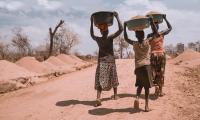CONCITO and the Summit for a New Global Financing Pact – still chasing “the trillions”
The Summit for a New Global Financing Pact held in Paris on 22-23 June was an important moment to bring together the interwoven agendas of sustainable development and the global challenges from climate change and losses of biodiversity and nature. The main focus of the event was on debt and vulnerability, MDB reform; existing and new sources of additional finance; and mobilization of private finance and investment.
The Summit was a response to calls from vulnerable countries led by Barbados and African countries to address global challenges related to climate change, biodiversity and sustainable development with a particular focus on the urgent needs of poor and vulnerable countries faced with multiple crises and increasing debt burdens. While many leaders of major economies – and smaller ones including Denmark – were absent as were hard commitments, the event provided a platform for amplifying the concerns and priorities of vulnerable and low income countries, signaling solidarity with the world’s poorest and willingness to act on global challenges.
In the runup to the Summit, it had become clear that expectations should neither be for a formal comprehensive “pact” nor for firm decisions on individual topics but more on generating momentum and creating a roadmap for a range of processes that will have to land and be decided upon in various multilateral and plurilateral forums such as the G20 and MDBs.
Key documents from the Summit include the French Chair’s summary and Roadmap document containing the most tangible outcomes, both produced by the host. A few concrete announcements with short term impact were announced, including on the introduction of clauses that provide for a pause in debt repayments for countries that are hit by climate disasters. As an illustration of the strong wish to show progress, the (likely) achievement of past 100Bn-promises related to climate finance and reallocation of SDRs were also celebrated.
Big picture summaries/assessments of the Summit have been made i.a. by Michael Jacobs and E3G.
The investment challenge was placed front and center from the very opening of the Summit, where Sir Nicholas Stern and Amar Bhattacharya laid out the investment and financing challenges as well as key steps to address them, backed by a summary of the landmark report from 2022. This happened days after Stern had addressed a conference on climate and development hosted by CONCITO and the Danish Minister Dan Jørgensen.
Stern and colleagues have made it clear that the investment challenge has made international financing for climate and development a whole new ballgame, in which several percentage points more of countries’ GDP need to go to savings that finance investments in energy transition, climate and development more broadly – and with a big chunk of this being channeled from developed and other countries with a surplus to emerging and developing economies (EMDEs).
While decisions about the World Bank and other MDBs are taken at their annual meetings, their roles and necessary reforms to their operating models were central to discussions at the Summit, where the new WBG President Ajay Banga had an opportunity to demonstrate his willingness to drive change. The main topics were the role of MDBs in protecting global public goods (climate and biodiversity) and handling tensions with prioritization of urgent crises and poverty alleviation – which Banga neatly addressed by framing the objective of the World Bank as “eliminating poverty on a livable planet”. The ability of the World Bank and other MDBs to “stretch their balance sheets” and provide more lending with existing – as well as new - capital remains a key theme. At the Summit, a group of around 50 developing and developed countries issued a joint MDB Vision Statement.
The Summit was never really designed to deliver a “pact” with solutions that match the trillion US$ investment challenge, but groups of leaders did signal areas of convergence and shared understanding of useful albeit mainly incremental improvements to the international “architecture”. Focusing on the investment challenge, I would highlight four high-level areas where –a shared understanding– at the level of leaders should be aimed for:
- Developed countries + China agreeing to mobilize and channel significantly higher levels of savings – with appropriate risk mitigation – toward investments in climate and development in EMDEs. The supply side of finance mobilization will require more focus, ranging from the macro implications of countries having to save more and to invest more in the “global south” to the specific barriers that exist also on the supply side of finance to making this happen.
- EMDEs agreeing to invest wisely in their economies and creating the conditions for international finance to flow at low risk/low cost. EMDEs would invest in ways that generate development, resilience and growth without undermining global public goods – climate and nature/biodiversity.
- Developed countries + China committing to provide catalytic and concessional finance through MDBs and other channels for: A) Vastly scaled up investment in human and institutional capital in EMDEs; B) Risk mitigation and blended finance to catalyze domestic and international investment and finance; C) Financing for public investments in adaptation as well as for loss and damage. New sources of finance have to be part of this, even though the Summit and other developments demonstrate how difficult this will be, even for the most low-hanging fruit – a levy on international shipping emissions.
- A push to further evolve the international ecosystem – including but not limited to MDBs – to ensure that it has the appropriate tools and acts in unison to provide effective, catalytic support with systemic impact.
In summary, the Summit from an investment mobilization perspective gave further momentum to key processes around mobilization by MDBs as well as risk mitigation instruments addressing currency and other risks. At the same time, it is fair to say that the scale of the challenge of getting to “the trillions” and the step-change required in developed and developing economies alike as well as in the international ecosystem of support and cooperation was not fully reflected.
CONCITO at the Summit: Catalytic action with systemic impact + the role of public financial institutions
CONCITO’s activities at the Summit reflect our focus on mobilizing investment and finance for climate and development, with a particular emphasis on the energy transition. CONCITO’s presence in Paris was centered around two Summit-endorsed Affiliated Events co-organized with the OECD addressing different perspectives on how to make the investment and finance flows for climate and development a reality, with a particular focus on investments I the energy transition.
Thanks to Stern, Bhattacharya and colleagues, the scale of the challenge has numbers attached to it: EMDEs excluding China need to invest around $1.5 Trillion per year by 2030 in the energy transition - a 7-fold increase from today’s levels - as part of overall climate investment needs of $2.4 trillion, which again are part of total investment and spending needs of $5.4 trillion for SDGs, climate and nature. Financing will have to come from domestic and international sources and be both public as private, concessional and non-concessional.
- Roundtable on a “dual systems approach” to investment mobilization.
A roundtable at the OECD convened governments, MDBs, DFIs, private finance, philanthropy, international organizations and experts to discuss how to catalyze investment by adopting more comprehensive, systems-oriented approaches both at the country level and internationally.
While these discussions are ongoing and elements of the solutions are being developed in various forums, this event focused on the need to take a comprehensive systems approach to getting to the trillions. Key elements of this approach are outlined in a recent blog that I wrote with Rui Luo at ClimateWorks Foundation.
At the country level, a whole-of-economy and whole-of-government approach is needed to cover real economy sectors (e.g., energy, industry, buildings, transport), the financial sector and macroeconomic and cross-cutting dimensions such as trade, industrial policy and taxation. Creating a conducive investment climate requires deployment of coordinated measures such as enabling policy and regulation, investment planning, and targeted use of risk-sharing instruments. When applied together, these measures contribute to turning investment needs into pipelines of investment opportunities and connecting them with finance. Macroeconomic and crosscutting factors are key as well, not least because macro risks directly affect the access to and cost of international capital.
At the international level, there is increasing focus on the effective provision of support by the international ecosystem of public, private and institutional actors. Multilateral development banks (MDBs) are being called upon to act as a system, and it is imperative that this is relevant to the wider ecosystem of international actors as well. Make no mistake – it may sound like a no-brainer but fragmentation is more common than comprehensive, coherent international cooperation around support for country level transformation. In addition, insufficient “soft” investment is going into human and institutional capacity to make the economy function more efficiently, generate pipelines of investable opportunities, and connect them with domestic and international finance.
Country platforms have been proposed as vehicles for increased alignment and cooperation between public and private as well as national and international actors, including with the launch of Just Energy Transition Partnerships (JETPs) in countries such as Indonesia, South Africa and Viet Nam, with Senegal joining the JETP family at the Summit.
It is obvious that systemic approaches require engagement from the highest levels of government and from those responsible for the overall development and investment trajectories. Ministries of finance will have to play a central role, and fortunately their engagement is being strengthened including through the Coalition of Finance Ministers for Climate Action, who are supporting ministries of finance in driving climate action.
- The role of MDBs and other DFIs in getting to the trillions
The second Affiliated Event was convened together with the OECD and European Climate Foundation.
The event showcased the impressive transformation by the Development Bank of Southern Africa (DBSA), which has, made a shift from a traditional development bank business model build on direct financing to one focused on catalysation and mobilisation. The affiliated event focused on how public financial institutions – ranging from MDBs and bilateral DFIs to National Development Banks – can fulfil their critical role in catalyzing private finance and in supporting the large necessary public investments in climate and development in emerging and developing economies. One of the ways this will be taken forward beyond the Summit is through a Private Sector Investment Lab.
To get to the trillions, MDBs and other public Fis must fully embrace their central catalytic role. MDBs are uniquely positioned to provide a wide range of catalytic functions to support this, covering both real economy sectors, the financial sector and macroeconomic issues.
CONCITO has highlighted catalytic functions that in particular MDBs would be well placed to perform and which would take their role in finance mobilization to a new level aiming to make a systemic impact. The MDBs could package commitments around these functions into a “Commitment to Catalyze”:
- Diagnostics of investment needs and investment readiness.
- Investment-enabling policy and regulation in multiple sectors
- Investment planning, market design and pipeline development
- Local financial sector and capital market development
- Provision of risk mitigation instruments addressing both macro and project level risks, thereby enabling pipelines of investments and their financing from domestic and international sources.
- Provision of vehicles and channels connecting private finance with investments through co-investment, re-financing of MDB portfolios etc., including with the use of blended finance.
- Convening country/sector platforms that bring together both national and international public, private and institutional actors around comprehensive, coherent action to catalyze investment in country/sector transitions.
- Engaging in international discussions about “upstream” international barriers to international investment and finance flows.
Going forward, CONCITO will continue to work with the OECD and multiple partners on ways to make the international ecosystem fit for the purpose of cooperating effectively with countries and sectors to make “the trillions” a reality




